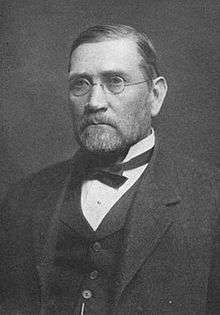George Lauder (Scottish industrialist)
| George Lauder | |
|---|---|
 | |
| Born |
November 11, 1837 Dunfermline, Fife, Scotland |
| Died |
August 24, 1924 (aged 86) Greenwich, Connecticut, United States |
| Resting place | Putnam Cemetery |
| Nationality | Scottish |
| Other names | Dod |
| Alma mater | University of Glasgow |
| Occupation | Mechanical Engineering, Business magnate |
| Known for | Revolutionizing the steel industry as a partner at the Carnegie Steel Corporation and later with U.S. Steel |
| Spouse(s) | Anna Maria Romeyn Varick |
| Children | George Lauder, Jr, Harriet Lauder Greenway, Elizabeth Storm Lauder |
| Parent(s) | George Lauder, Sr. & Seaton Morrison |
| Relatives |
Andrew Carnegie Thomas M. Carnegie G. Lauder Greenway James Greenway Polly Lauder Tunney John V. Tunney |
George Lauder (November 11, 1837 – August 24, 1924) was a Scottish industrialist. A trained engineer, he was the "cousin-brother" of steel magnate and philanthropist Andrew Carnegie, and a partner in the Carnegie Steel Corporation.[1] The sale of Carnegie Steel to J.P. Morgan created U.S. Steel where Lauder was on the board of directors. This was the first corporation in the world with a market capitalization exceeding $1,000,000,000.00.
Early years
George Lauder was the son of George Lauder, Sr. and Seaton Morrison. His father, a local shop owner on the high street, also known for his commitment to Scottish nationalism, egalitarian democracy, and the Chartism cause. He was a keen radical for the time, championing the preservation of human and public rights which led to the Reform Acts of 1836. Very well read, Lauder Sr. was instrumental in the upbringing of his only son George, as well as his nephew Andrew Carnegie.[2]
Lauder Jr. and Carnegie were two years apart in age and best friends as a result of their shared experiences. They affectionately referred to one another as "Dod" and "Naig" (respectively),[3] due to their mutual inability to full say each other's names as young children. After Andrew and his family left for America, George stayed in Scotland where he would go on to graduate from Glasgow University with a degree in mechanical engineering while studying under Lord Kelvin.[2]
Business life
Carnegie wrote to Lauder, who had never ceased to be his closest confidant and advisor, asking him to join him in America as a partner in the Carnegie Steel Corporation. At the time, the major shareholders were Carnegie himself, Carnegie's brother Thomas M. Carnegie, Henry Phipps, Jr., and Henry Clay Frick. Lauder accepted and joined Carnegie in Pittsburgh.
Lauder, due to his expertise in mechanical engineering, which was unique among the partners of the business, brought several new developments to the steel industry in America. These included the process for washing and coking dross from coal mines, which resulted in a significant increase to the overall value of the business.[2]
Lauder would also go on to lead the development of the use of steel in armor and armaments, spending significant time at the Krupp factory in Germany in 1886 before returning to build the massive armor plate mill at the Homestead Steel Works that would revolutionize warfare forever.[1]
By the turn of the twentieth century, Lauder was a director of Carnegie Steel and its second largest shareholder after Carnegie.[1]
After the successful sale of Carnegie Steel Corporation to J.P. Morgan, leading to the formation of U.S. Steel in 1901, Lauder joined the board of directors of the new company which became the first corporation in the world with a market capitalization exceeding $1,000,000,000.00.
Marriage and Issue
George Lauder married Anna Maria Romeyn Varick. His wife, a member of old Dutch New York Society, was a descendant of both Richard Varick and Joris Jansen Rapelje.
They had three children together. They had two daughters including Harriet Lauder Greenway who married Dr. James C. Greenway, the founder of the Yale School of Public Health and purchased what would become The Lauder Greenway Estate in Greenwich. Their children included renowned ornithologist James Cowan Greenway, arts patron G. Lauder Greenway who lead the Metropolitan Opera Association, and pioneering pilot and CIA officer Gilbert C. Greenway. Their other daughter was Elizabeth Storm Lauder.
Their son, George Lauder, Jr. was a world-renowned yachtsman whose yacht, the Endymion, held multiple records including the fastest trans-Atlantic crossing. His daughter Polly Lauder Tunney would later marry Gene Tunney in one of the most talked about marriages of the early 20th Century. Their son John V. Tunney would go on to become a congressman and senator from California.
Family Estate
George Lauder lived out the last twenty years of his life at The Lauder Greenway Estate, now known as Copper Beech Farm, in Greenwich, CT. Still the largest private waterfront estate between New York City and Greenwich, it became the most expensive private residence in the United States in 2014 when it sold for $120 million dollars.[4]
References
- 1 2 3 Skrabek, Quentin R. (2012). The Carnegie Boys: The Lieutenants of Andrew Carnegie that Changed America. Jefferson, NC: McFarland & Company, Inc. p. 22. ISBN 978-0-7864-6455-5.
- 1 2 3 Carnegie, Andrew (1920). The Autobiography of Andrew Carnegie. New York and Boston: Houghton Mifflin Company. pp. 15, 144. ISBN 1609421981.
- ↑ Edge, Laura Bufano (2004). Andrew Carnegie: Industrial Philanthropist. Minneapolis, MN: Lerner Biographies. p. 12. ISBN 0-8225-4965-4.
- ↑ Carlyle, Erin (16 April 2014). "Most Expensive U.S. Home Sale Ever: Connecticut Estate Goes For $120 Million". Forbes.